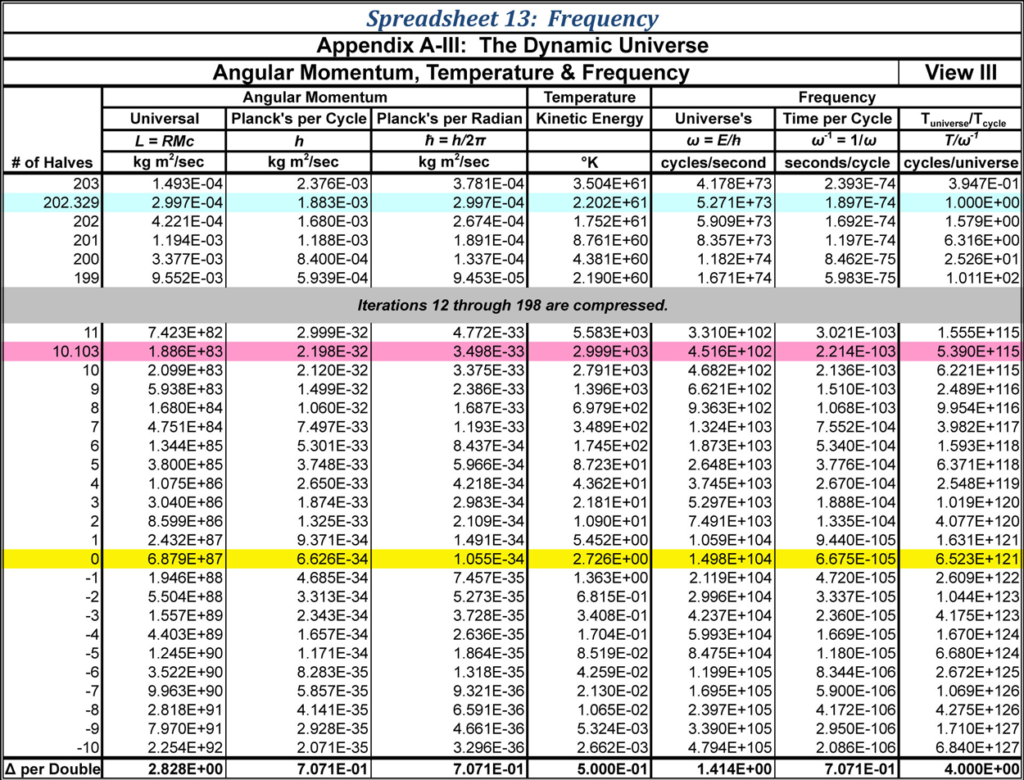Download this chapter for offline viewing (no videos, 1MB)
Download this chapter for offline viewing (includes video content, 47MB)
Matter and energy are structured with waveforms. These waves generate events with each passage through the midpoint of the wave. The frequency of these waves is determined by the energy of the mass or electromagnetic impulse. In total they add up to the frequency and the event generating capability of the Universe.
Fundamental Waveforms
Waveforms are the source of all event formation. Events are the foundation of the Universe’s expansion. Event generation is embodied in the nature of the black hole Universe. Its rate of formation is a mathematical absolute and therefore becomes another knowable component of the Occam Razor model.
Waveforms exist in the movement of light and matter, but are also resident in matter itself. Waveforms are embedded in the strong, weak and electromagnetic forces that make up matter. When all of these waves are added, the combined frequency is equal to matter’s contribution to the event generation of the Universal Black Hole.
Frequency
The event formation capability of the Universe is a summation of the all the waveforms generated by matter and various forms of energy. Therefore, the event generating capability of the Universe is its total energy content divided by Planck’s angular momentum. Events are a dimensionless feature of the counting universe, yet these events are preserved in the mass and memory of the evolving cosmos. The rate of event generation for the Universe is its frequency.
For light, frequency is its energy divided by Planck’s angular momentum.
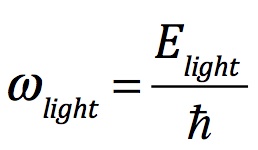
If the total energy content of the Universe is divided by Planck’s angular momentum, the frequency of event formation is determined. The total events generated every second for the Universe at its current age are 1.498179 • 10104Hz.

Mass Exchange and Event Creation
As in light, every time that a sine wave crosses the zero meridian mass and energy are exchanged. Therefore, the frequency of the Universe becomes its event generating capacity:

Each exchange causes a Planck-Otto unit of energy to be generated. With light, every sine wave crossover from the positive domain to the negative or negative to positive produces a Planck-Otto waveform, which is deposited in space. However, with matter, this waveform is retained by its force structure and is added to the mass of the particle. In this way matter’s mass increases with the accumulated experience of its events while light’s energy dissipates.
Change in the Universe’s Frequency
Since the energy of the Universe divided by Planck’s angular momentum was different in the past, the frequency of event creation has changed. The Universe’s energy has been constant throughout its existence. However, Planck’s angular momentum has decreased in time to its current level. If energy and Planck’s angular momentum values are used for prior times in the Universe’s history, the frequency of event formation can be determined for different points in the past.
The frequency of the Universe at the CBR event was:
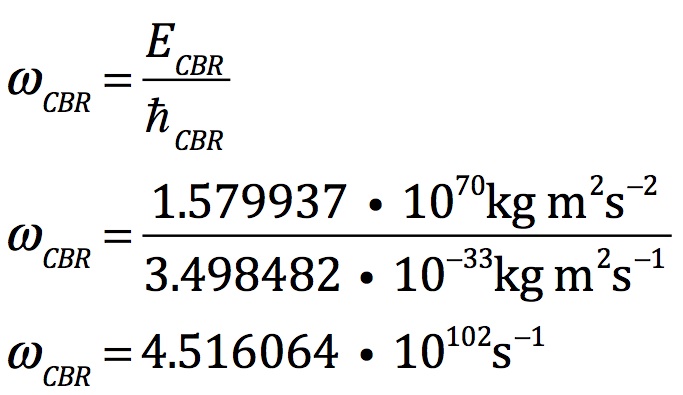
The frequency of the Universe at the Big Bang was:
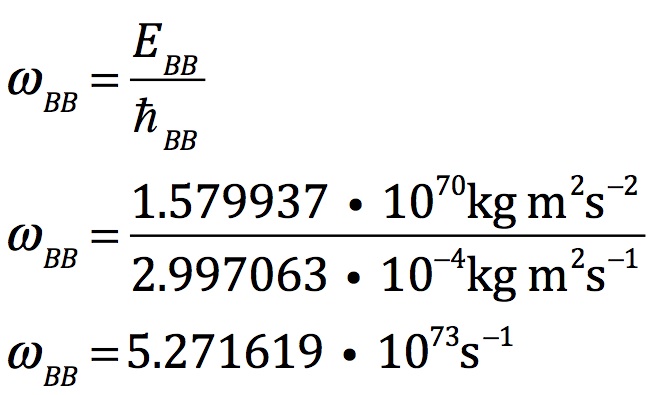
Not All Sources of Mass/Energy Are Equal
Planck-Otto mass and energy are generated with every waveform within the Universe. Sometimes, such as with the movement of light through space, these waveforms are dissipated into open space. Once these waveforms are generated, they reside permanently in the history of the Universe. These half waveforms lengthen with the expansion of space. One end of the waveform is anchored in the point of spacetime where the event was formed. The other is anchored in the ever expanding zero layer.
However, this mass continues to exist and affect the Universe gravitationally. It is the elusive dark mass. Dark mass is space itself. These waveforms exist in static form – one node stuck in the spacetime of the event that formed the wave and the other on the cusp of the expanding Universe’s event horizon. They continue to lengthen with the expansion. Therefore, they cannot cross over to form a new wave. It is dark because these waveforms are so attenuated that they can no longer interact with other forms of matter and energy other than through the gravitational curvature of spacetime.
But the event generating capability of the Universe is based upon the mass of the entire Universe. It has just been stated that Planck-Otto mass no longer can generate events; it only records them. Dark mass does not generate events. What makes up for this shortfall?
Matter’s Event Generating Potential
Matter is a complex waveform. Light travels through time but does not experience time. Matter both travels through time and experiences it. To experience time means that matter holds on to its experience, i.e., it retains its connection with its Planck-Otto waveforms. These waveforms are how the Universe remembers.
The frequency for the entire Universe is determined by dividing its energy content by Planck’s angular momentum. The problem is that part of the Universe’s energy content comes from dark mass. Dark mass’s mass represents a significant portion of the Universe’s mass.
Dark Mass Defined
The angular momentum from the revolution of galaxies far exceeds gravitational curvature achievable from the observable mass. Even if a liberal estimate of the mass from dust and black holes are considered, there is a substantial deficit in mass. This deficit is assumed to reside in the theoretical particles known as dark mass.
It is believed there are non-interacting particles that make up dark mass. The details of the physics of these particles is tentative. These theoretical particles do not interact with the three non-gravitational forces. This makes this mass dark.
Occam’s Razor advances the theory that dark mass is space itself. The clearest example of how this might be is the black hole. Black holes are not composed of matter particles even though its formation results from the collapse of the structure of matter that formed the black hole. The strong, weak and electromagnetic forces no longer exist within a black hole. So could space itself have mass?
For example, why does a supernova explode so violently when formed? Vast quantities of energy are released, but with the collapse of a supermassive star the end product might be a black hole. Black holes can absorb endless energy. Yet despite this one-way street inward, the supernova that produces the black hole will still expel a substantial part of the progenitor star’s mass in the supernova.
What is created with a star collapse is a copious quantity of free space. The collapse of electron orbits into neutrons releases the space between. This released space expands instantly imparting its energy to the star’s outward moving layers above.
Occam’s Razor defines dark mass as space itself. Space is inert, but it retains its mass. When light travels through space, it generates an event for each half wavelength. These waveforms are deposited in open space as events. Those events generate a Planck-Otto waveform that marks the location of each event, and also adds one Planck-Wheeler square area to the Universal Black Hole’s surface.
Consequently, light loses a Planck-Otto unit of energy in transit. The Planck-Otto waveform also carries a Planck-Otto unit of mass. This mass added to the Universe.
How Planck-Otto emissions differ from normal wavelengths is the inability for these attenuated waveforms to interact with normal matter or energy. This non-reactive nature of this form of mass is the definition of dark mass.
Restated: Dark matter is mass that can no longer interact with normal matter or energy. Space is dark mass.
Space does not have uniform density. It is concentrated around sources of event formation. Space is generated by events, and it spreads from the location where they were formed.
Frequency: The Rate of Event Formation
Events are produced by the exchange of mass and energy. Each event comes with the release of a Planck-Otto waveform. Light’s waveforms are open when a Planck-Otto energy unit is released, its mass is deposited into open space.
Matter, however, encloses its waveforms into confined space defined by the electromagnetic, strong, and weak forces. Matter remembers its experience by retaining these waveforms. As a consequence, matter retains most of its Planck-Otto mass.1
Dark mass is history. It generates no events in the present. Its frequency is zero.
It has already been shown that the rate of event formation is the total energy of the Universe divided by Planck’s angular momentum. Since dark mass, i.e., space, is the majority of the Universe’s energy, how is the event formation deficit recovered?
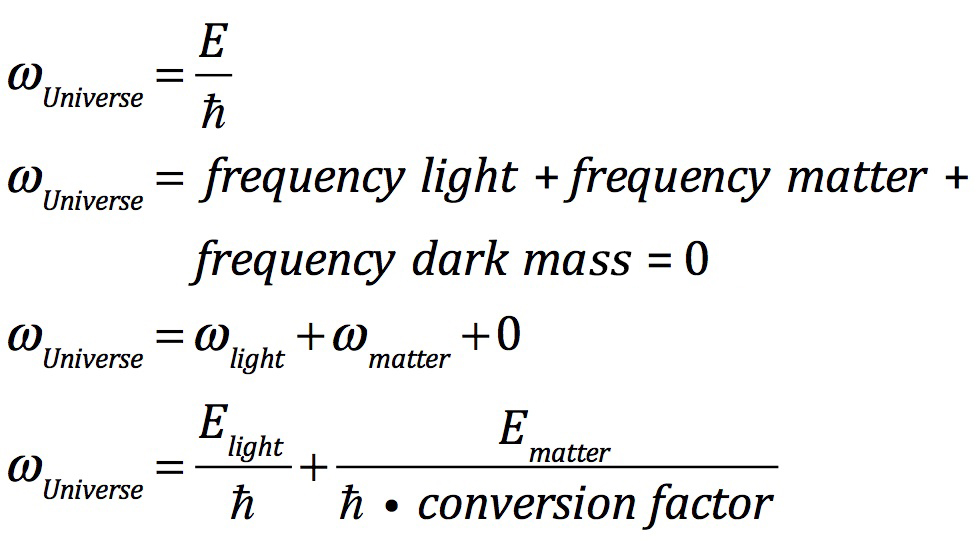
It is the complex structure of matter that enables it to generate the missing event formation from dark mass. The embedded differential is built into the conversion factor.
In 1924 Louis de Broglie hypothesized that matter has waveforms just as light’s photons do. He postulated that matter particles exhibit wave characteristics as well the wave-particle duality of light. This was proved a short time later.
Matter with a mass below the Planck-Wheeler limit moves in waves. de Broglie determined there were two superimposed waves: 1) the phase wave, and 2) the group wave. The phase wave frequency is designated by omega (ω), and the group wave frequency is (fg). 𝓌 is the phase wave velocity, and 𝑣 the group wave velocity. The phase wave is superluminal and makes up the substance that moves in the group wave. The group wave travels at the velocity of the particle.
His theory established that particles have complex wave patterns. Just as waves in the ocean have short wave oscillations with higher frequencies within larger “group” waveforms traveling with longer wavelengths; matter is comprised of complex waveforms. The “group wave” registers the movement of the entire particle. The group wave is superimposed on the “phase wave”. The velocity of these two waveforms when multiplied together equal c2.
If one ever watched a propeller of a prop-based airplane accelerate, it shows two apparent motions. These seem to overlap. The first is the velocity of the propeller. This velocity becomes progressively more difficult to follow. A second harmonic appears. This is of a rotating image that is slower and at times reverses direction. While the propeller analogy is only perceptual, it illustrates wave superimposition.
Since the group wave is the velocity of the particle, which is always less that the velocity of light, the phase wave must be superluminal.

Since all quantum waveforms generate events, matter’s compound wave structure, phase and group wave, increase matter’s event generating capability. The strong, weak, and electromagnetic forces, which contain free energy into form, add to the event generating capacity of matter.
Events generated traveling through space, i.e., moving contrary to ambient space, age at a slower pace. The slower movement of time is traded for movement in space. That movement is the group wave of de Broglie’s theory. These waveforms, like light, travel through space and leave these events in spacetime. Events formed by matter’s containment forces are retained by that matter as additional mass. These events are part of matter’s memory. That memory comes in the form of aging.
Matter Has Two Experiences of Time
Light travels through time but does not experience time. However, matter both moves through time and retains time’s experience. Therefore, matter has two times. There is a frequency for each. In total these add up to the total frequency for matter. For this reason energy in the form of matter contributes more to event formation than energy in light. The Special Relativity and General Relativity effects change the proportion of space versus time experienced by matter. This tradeoff is built into the cumulative event formation capacity of matter. In reality it is the nature of event formation that is the source of Special Relativity and General Relativity’s effect on time. Both principles have their basis in the quantum mechanics of event formation.
